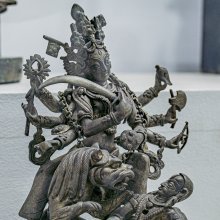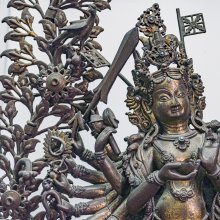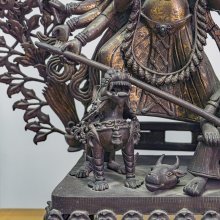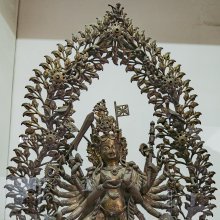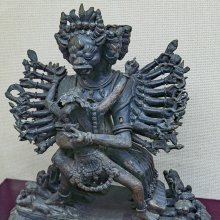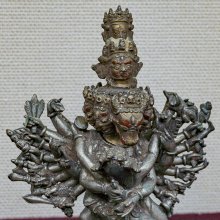Mahisha, Mahiṣa, Mahisa, Māhiṣa, Mahīśa: 38 definitions
Introduction:
Mahisha means something in Buddhism, Pali, Hinduism, Sanskrit, Marathi, Jainism, Prakrit, Hindi. If you want to know the exact meaning, history, etymology or English translation of this term then check out the descriptions on this page. Add your comment or reference to a book if you want to contribute to this summary article.
The Sanskrit terms Mahiṣa and Māhiṣa and Mahīśa can be transliterated into English as Mahisa or Mahisha, using the IAST transliteration scheme (?).
Alternative spellings of this word include Mahish.
Images (photo gallery)
(+6 more images available)
In Hinduism
Ayurveda (science of life)
Dietetics and Culinary Art (such as household cooking)
Source: Shodhganga: Dietetics and culinary art in ancient and medieval IndiaMāhiṣa (माहिष) refers to a type of fish whose meat (māṃsa) is classified as “aquatic” (apcara) according to the 17th century Bhojanakutūhala (dravyaguṇāguṇa-kathana), and is commonly found in literature dealing with the topics of dietetics and culinary art, also known as Pākaśāstra or Pākakalā.—The text [māṃsa-prakaraṇa] says the three fold division of meat [such as aquatic (apcara)...]. Here different types of meat and their properties are discussed in detail. The aquatic animals are [viz., māhiṣa].
Veterinary Medicine (The study and treatment of Animals)
Source: Shodhganga: Portrayal of Animal Kingdom (Tiryaks) in Epics An Analytical studyMahiṣa (महिष) refers to either the Buffalo or the Murrah breed (Bubalus bubalis), according to scientific texts such as the Mṛgapakṣiśāstra (Mriga-pakshi-shastra) or “the ancient Indian science of animals and birds” by Hamsadeva, containing the varieties and descriptions of the animals and birds seen in the Sanskrit Epics such as the Ramayana and Mahabharata.
Unclassified Ayurveda definitions
Source: Wisdom Library: Āyurveda and botanyMahiṣa (महिष) is a Sanskrit word referring to the animal “buffalow”. The meat of this animal is part of the māṃsavarga (‘group of flesh’), which is used throughout Ayurvedic literature. The animal Mahiṣa is part of the sub-group named Ānupamṛga, refering to animals “who live in marshy land”. It was classified by Caraka in his Carakasaṃhitā sūtrasthāna (chapter 27), a classical Ayurvedic work. Caraka defined such groups (vargas) based on the dietic properties of the substance.
The meat of the buffalow (mahiṣa) is unctuous, hot, sweet, aphrodisiac, heavy and saturating. It produces firmness, bulk, courage and sleep.
Source: archive.org: Sushruta samhita, Volume IMahiṣa (महिष)—Sanskrit word for the animal “buffalo” (Bubalus bubalis). This animal is from the group called Kūlacara (‘shore-dwellers’). Kūlacara itself is a sub-group of the group of animals known as Ānupa (those that frequent marshy places).
The flesh of the Buffalo is demulcent, heat-making (in its potency), sweet, spermatopoietic, pleasant and heavy of digestion It increases strength and virility and imparts firmness to the tissues, and is hypnotic and galactagoguic.
Source: archive.org: Vagbhata’s Ashtanga Hridaya Samhita (first 5 chapters)Māhiṣa (माहिष) refers to “milk coming from the buffalo”, as mentioned in verse 5.21-23 of the Aṣṭāṅgahṛdayasaṃhitā (Sūtrasthāna) by Vāgbhaṭa.—Accordingly, “[...] among the (different kinds of milk [viz., payas]), [...] wholesome for those stricken with excessive digestion and insomnia, very heavy, (and) cooling (is) buffalo’s [viz., māhiṣa] milk”.
Note: Māhiṣa (“buffalo’s milk”) has been transferred to the head of the sentence and reproduced by ma-hei o-ma, for which NP have substituted the grammatically less correct ma-he o-ma. As māhiṣa has come to stand before atyagnyanidra, so has hita come to stand after it.

Āyurveda (आयुर्वेद, ayurveda) is a branch of Indian science dealing with medicine, herbalism, taxology, anatomy, surgery, alchemy and related topics. Traditional practice of Āyurveda in ancient India dates back to at least the first millenium BC. Literature is commonly written in Sanskrit using various poetic metres.
Purana and Itihasa (epic history)
Source: Wisdom Library: Varāha-purāṇa1) Mahiṣa (महिष).—Name of a settlement (janapada) situated near the seven great mountains on the western side of mount Naiṣadha, according to the Varāhapurāṇa chapter 83. These settlements consume the water flowing from these seven great mountains (Viśākha, Kambala, Jayanta, Kṛṣṇa, Harita, Aśoka and Vardhamāna). Niṣadha (Naiṣadha) is one of the seven mountains located in Jambūdvīpa, ruled over by Āgnīdhra, a grandson of Svāyambhuva Manu.
2) Mahiṣa (महिष).—One of the seven major mountains in Kuśadvīpa, according to the Varāhapurāṇa chapter 87. It is also known by the name Hari. Kuśadvīpa is one of the seven islands (dvīpa), ruled over by Vapuṣmān, one of the ten sons of Priyavrata, son of Svāyambhuva Manu.
Svāyambhuva Manu was created by Brahmā, who was in turn created by Nārāyaṇa, the unknowable all-pervasive primordial being.
The Varāhapurāṇa is categorised as a Mahāpurāṇa, and was originally composed of 24,000 metrical verses, possibly originating from before the 10th century. It is composed of two parts and Sūta is the main narrator.
Source: archive.org: Puranic EncyclopediaMahiṣa (महिष).—An Asura.
. Birth. Long ago there was a famous Asura King named Danu. Two sons named Rambha and Karambha were born to him. Having no issue, they decided to worship Mālavaṭa yakṣa, praying to be blessed with children. They started tapas, Karambha, in the middle of water and Rambha in the middle of Pañcāgni. Indra was alarmed at their tapas. He took the form of a crocodile and went into the water in which Karambha was standing and caught hold of his feet, pulling him down. Karambha was drowned. The mighty Rambha who was enraged at the death of his brother, decided to cut off his own head and offer it as sacrifice in the fire. He drew his sword and was about to cut off his head, when Agni, the god of fire, appeared before him and stopped him saying:—"Do not kill yourself. Killing another person itself is a sin. Suicide is a more serious sin. Ask for any boon you wish to have; I shall grant it. Do not put an end to your life." (See full article at Story of Mahiṣa from the Puranic encyclopaedia by Vettam Mani)
Source: archive.org: Shiva Purana - English TranslationMahiṣa (महिष) refers to a “buffalo” and represents the mount of Yama, according to the Śivapurāṇa 2.2.36. Accordingly, as Brahmā narrated to Nārada:—“Indra mocked at Viṣṇu who was engrossed in his own arguments. He, the bearer of the thunderbolt, was desirous of fighting Vīrabhadra along with the other Devas. Then Indra rode on his elephant, the fire-god rode on a goat, Yama rode on his buffalo (mahiṣa) and Nirṛti rode on a ghost”.
Source: Cologne Digital Sanskrit Dictionaries: The Purana Index1a) Mahiṣa (महिष).—A son of Anuhrāda and Sūrmyā: fought with Vibhāvasu in the Devāsura war.*
- * Bhāgavata-purāṇa VI. 18. 16; VIII. 10. 32.
1b) The son of Āyu and father of Sahasa.*
- * Brahmāṇḍa-purāṇa II. 12. 40.
1c) A mountain of Kuśadvīpa (Śālmalidvīpam br., vā., and Viṣṇu-purāṇa); here lives a fire called Mahiṣa, and born of waters.*
- * Brahmāṇḍa-purāṇa II. 19. 40-41. Matsya-purāṇa 122. 59-60; Vāyu-purāṇa 49. 37. Viṣṇu-purāṇa II. 4. 27.
1d) The name of a water-born fire in the Mahiṣa hill of the Śālmalidvīpa.*
- * Brahmāṇḍa-purāṇa II. 19. 41; Vāyu-purāṇa 49. 37.
1e) An Asura residing in Rasātalam;1 was present at Tāraka's coronation; a commander of Tāraka's force and had a chariot drawn by camels;2 threw sāvitram astra against Kubera; defeated both Nṛṛti and Varuṇa and released Kujambha from the noose; somāstra and vāyavyāstra throwing out snow and wind, were sent to disable the Asuras, when Kālanemi created a glowing fire by māyā and removed the snow and wind etc;3 found Mathana vanquished by Janārdana and sent his Śūla against Janārdana and Śakti against Garuḍa when Janārdana repelled him and said: “You are to be killed by a woman; get away;4 killed by Durgā.5
- 1) Brahmāṇḍa-purāṇa II. 20. 39.
- 2) Matsya-purāṇa 147. 28; 148. 42, 50.
- 3) Ib. 150. 113, 135; 151. 13.
- 4) Ib. 152. 17-24.
- 5) Brahmāṇḍa-purāṇa IV. 29. 75 and 88.
1f) A son of Maya.*
- * Brahmāṇḍa-purāṇa III. 6. 29; Vāyu-purāṇa 68. 28.
1g) The kingdom of, to be ruled over by Guha.*
- * Brahmāṇḍa-purāṇa III. 74. 198.
1h) Born of Surabhī; Buffalo as the riding animal of Yama; as also of Vārāhī;1 its flesh for śrāddha.2
1i) An Asura of Śrītalam.*
- * Vāyu-purāṇa 50. 38.
1j) A Vindhyan tribe: Puṣpamitra was a king;1 born of Haṃsa Kāli;2 the kingdom of.3
1k) A Janapada of the Ketumālā continent.*
- * Vāyu-purāṇa 44. 12.
2a) Māhiṣa (माहिष).—The region under the Guhas.*
- * Viṣṇu-purāṇa IV. 24. 65.
2b) A royal dynasty.*
- * Vāyu-purāṇa 99. 374.
Mahiṣa (महिष) is a name mentioned in the Mahābhārata (cf. IX.44.77) and represents one of the many proper names used for people and places. Note: The Mahābhārata (mentioning Mahiṣa) is a Sanskrit epic poem consisting of 100,000 ślokas (metrical verses) and is over 2000 years old.

The Purana (पुराण, purāṇas) refers to Sanskrit literature preserving ancient India’s vast cultural history, including historical legends, religious ceremonies, various arts and sciences. The eighteen mahapuranas total over 400,000 shlokas (metrical couplets) and date to at least several centuries BCE.
Natyashastra (theatrics and dramaturgy)
Source: archive.org: Natya ShastraMahiṣa (महिष).—Description of a women of buffalo (mahiṣa) type;—A woman who has a broad backbone, teeth, sides, belly, tawny hairs, is turbulent and hater of men, fond of intercourse, has a slightly broad (lit. raised) mouth, large forehead and hips, and is fond of forests and sporting in water, has the nature of a buffalo (mahiṣa).

Natyashastra (नाट्यशास्त्र, nāṭyaśāstra) refers to both the ancient Indian tradition (shastra) of performing arts, (natya—theatrics, drama, dance, music), as well as the name of a Sanskrit work dealing with these subjects. It also teaches the rules for composing Dramatic plays (nataka), construction and performance of Theater, and Poetic works (kavya).
Dharmashastra (religious law)
Source: Prācyā: Animals and animal products as reflected in Smṛti textsMahiṣa (महिष) refers to the animal “Buffalo” (Bubalus bubalis).—The Smṛtis mention several domestic as well as wild animals that are enumerated in context of specifying expiation for killing them, the flesh being used as a dietary article to give satisfaction to the Manes (Pitṛs) in Śrāddha rites, the law of transmigration due to various sins committed as well as in the context of specifying gifts to be given on various occasions. These animals [viz., Mahiṣa] are chiefly mentioned in the Manusmṛti, Parāśarasmṛti [Chap.6], Gautamasmṛti [17.2 and 15.1], Śātātapasmṛti [II.45-54], Uśānasmṛti [IX.7-9; IX.12-13], Yājñavalkyasmṛti [I.170-171; I.175; I.258- 260], Viṣṇusmṛti [51.3;51.6;51.26;51.33;80.3-14], Uttarāṅgirasasmṛti [X.15-17], Prajāpatismṛti [Śrāddhatyājyavastuvarṇanam. 138-143], 9 Kāśyapasmṛti [Section on Prāyaścittavarṇanam], Vṛddha Hārītasmṛti [6.253-255] and Kātyāyanasmṛti [27.11].

Dharmashastra (धर्मशास्त्र, dharmaśāstra) contains the instructions (shastra) regarding religious conduct of livelihood (dharma), ceremonies, jurisprudence (study of law) and more. It is categorized as smriti, an important and authoritative selection of books dealing with the Hindu lifestyle.
Shaktism (Shakta philosophy)
Source: Google Books: ManthanabhairavatantramMahiṣa (महिष) is a king of the demons slain by the Goddess, according to the Kularatnoddyota (chapter 9).—We are told in the Kularatnoddyota that prior to the goddess’s incarnation in the nineteenth kalpa as Dakṣa’s daughter, she will come into the world to kill the demons Caṇḍa and Muṇḍa. Then as Durgā and Kātyāyaṇī in “a black and brown (kṛṣṇapiṅgalā)” form she will slay Mahiṣa, the king of the demons. She then appears again in the end of the Dvāpara Age, as described in the Purāṇas, to slay the evil king Kaṃsa and thereby save the newly-born Kṛṣṇa. Again, the Jayadrathayāmala says practically the same, identifying the goddess of the nineteenth and last age as Bhadrakālī.

Shakta (शाक्त, śākta) or Shaktism (śāktism) represents a tradition of Hinduism where the Goddess (Devi) is revered and worshipped. Shakta literature includes a range of scriptures, including various Agamas and Tantras, although its roots may be traced back to the Vedas.
Jyotisha (astronomy and astrology)
Source: Wisdom Library: Brihat Samhita by Varahamihira1) Mahiṣa (महिष) refers to a “buffalo”, according to the Bṛhatsaṃhitā (chapter 3), an encyclopedic Sanskrit work written by Varāhamihira mainly focusing on the science of ancient Indian astronomy astronomy (Jyotiṣa).—Accordingly, “If at rising and setting the sun should be hid by clouds of the shape of implements of war, he will bring on strife; if these clouds should appear like a deer, a buffalo, a bird, an ass or a young camel [i.e., mṛga-mahiṣa-vihaga-khara-karabha-sadṛśa], mankind will be afflicted with fears. The planets, when subjected to the hot rays of the sun are freed from their impurities just as gold is purified by the action of the fire”.
2) Mahiṣa (महिष) is the name of an ancient kingdom or tribe of people, according to the Bṛhatsaṃhitā (chapter 9).—Accordingly, “The four constellations from Bharaṇi are known as the first maṇḍala (circle or division). If Venus should reappear in it there will be prosperity in the land; the people of Vaṅga and of Aṅga, the Mahiṣas, the Vāhlīkās and the Kaliṅgas will be afflicted with fears. If Venus, who so reappears in the said circle, should be crossed by a planet, the rulers of the Bhadrās, of the Aśvas, of Śūrasenakas and of the Yaudheyas and Koṭivarṣa will perish”.

Jyotisha (ज्योतिष, jyotiṣa or jyotish) refers to ‘astronomy’ or “Vedic astrology” and represents the fifth of the six Vedangas (additional sciences to be studied along with the Vedas). Jyotisha concerns itself with the study and prediction of the movements of celestial bodies, in order to calculate the auspicious time for rituals and ceremonies.
Kavya (poetry)
Source: Brill: Śaivism and the Tantric Traditions (kavya)Mahiṣa (महिष) refers to a “buffalo”, according to Bāṇa’s Kādambarī (p. 226).—There is a mix of suspicion, fear and reverential awe underlying the image of the forbidding shrine tucked away in the wilds, with its Tāntrika priest who knows not how ‘appropriate’ worship should be conducted, and its blood-spattered, grisly interiors.The very opposite of this ambivalent attitude surfaces in Bāṇa’s unequivocally laudatory poem to Durgā, the Caṇḍīśataka—verse 8 of which is consciously alluded here in “she seemed to be scolding the wild buffalo (vana-mahiṣa) who had offended by moving the trident-shaft by scratching his shoulders [on it]”

Kavya (काव्य, kavya) refers to Sanskrit poetry, a popular ancient Indian tradition of literature. There have been many Sanskrit poets over the ages, hailing from ancient India and beyond. This topic includes mahakavya, or ‘epic poetry’ and natya, or ‘dramatic poetry’.
Vastushastra (architecture)
Source: Brill: Śaivism and the Tantric Traditions (architecture)Māhiṣa (माहिष) refers to a “buffalo”, according to the Devyāmata (in the section śalyoddhāra-paṭala or “excavation of extraneous substances”).—Accordingly, “[...] If a horse steps over [a cord], [the officiant] should prognosticate an extraneous thing related to a buffalo (māhiṣa) [, i.e. the bone of a buffalo beneath the ground. If a buffalo (māhiṣa) steps over [a cord], there is the bone of a jackal [beneath the site]. [...]”.

Vastushastra (वास्तुशास्त्र, vāstuśāstra) refers to the ancient Indian science (shastra) of architecture (vastu), dealing with topics such architecture, sculpture, town-building, fort building and various other constructions. Vastu also deals with the philosophy of the architectural relation with the cosmic universe.
Shaivism (Shaiva philosophy)
Source: SOAS University of London: Protective Rites in the Netra TantraMahiṣa (महिष) refers to a “buffalo” (i.e., ‘riding on buffalos in dreams’), according to the Svacchanda-tantra.—Accordingly, [verse 4.21-27, while describing inauspicious dreams]—“[...] [He dreams of] the destruction of houses, palaces, beds, clothes, and seats; defeat of oneself in battle and theft of ones things. [He] ascends or is amongst donkeys, camels, dogs, jackals, and herons, vultures, and cranes. [He rides on] buffalos (mahiṣa), owls, and crows, eats cooked meat, [wears a] red garland, and ointment for the body. [...]”

Shaiva (शैव, śaiva) or Shaivism (śaivism) represents a tradition of Hinduism worshiping Shiva as the supreme being. Closely related to Shaktism, Shaiva literature includes a range of scriptures, including Tantras, while the root of this tradition may be traced back to the ancient Vedas.
Shilpashastra (iconography)
Source: Shodhganga: Elements of Art and Architecture in the Trtiyakhanda of the Visnudharmottarapurana (shilpa)Mahiṣa (महिष) refers to “buffalo” and in iconography is associated with Yama, according to the Viṣṇudharmottarapurāṇa, an ancient Sanskrit text which (being encyclopedic in nature) deals with a variety of cultural topics such as arts, architecture, music, grammar and astronomy.—In the context of having mahiṣa i.e., a buffalo as vāhana of Yama, the view points of the Viṣṇudharmottarapurāṇa , the Kāśyapaśilpa and the Śilparatna seem to be similar. Thus it is clear that the Viṣṇudharmottarapurāṇa offers a great field of knowledge regarding the nuances of Indian art of Image making [e.g., mahiṣa—buffalo] during 10th–11th century A.D.

Shilpashastra (शिल्पशास्त्र, śilpaśāstra) represents the ancient Indian science (shastra) of creative arts (shilpa) such as sculpture, iconography and painting. Closely related to Vastushastra (architecture), they often share the same literature.
General definition (in Hinduism)
Source: Academia.edu: The Rite of Durgā in Medieval BengalIn the Kālikā Purāṇa (verse 60.146) a legend appears where Śiva (girīśa) is described as being incarnated as Mahiṣa in the womb of a female buffalo. In brief, the background to this event is as follows. Mahiṣa’s father Rambha is a devout follower of Śiva. Pleased with his worship, Śiva grants him a boon that he himself will be born as Rambha’s son. On his way home, Rambha falls madly in love with a young and pleasing she-buffalo, whom he impregnates. Śiva imbues the foetus in the buffalo’s womb with a portion from his body.
Similar myths where Mahiṣāsura is depicted in a sympathetic light as a Śiva devotee and a ‘portion descendant’ (aṃśāvatāra) of Śiva also appear in Tamil texts from the period such as the Aruṇācalapurāṇa, a study of which appears in Shulman 1976, pp. 122–123. There is no mention of Śiva being the sacrificial animal in texts from the early medieval period which leads me to believe that it is a medieval development.
In Buddhism
Tibetan Buddhism (Vajrayana or tantric Buddhism)
Source: Wisdom Library: Tibetan BuddhismMahiṣa (महिष) is the name of a Rāśi (zodiac sign) mentioned as attending the teachings in the 6th century Mañjuśrīmūlakalpa: one of the largest Kriyā Tantras devoted to Mañjuśrī (the Bodhisattva of wisdom) representing an encyclopedia of knowledge primarily concerned with ritualistic elements in Buddhism. The teachings in this text originate from Mañjuśrī and were taught to and by Buddha Śākyamuni in the presence of a large audience (including Mahiṣa).
Source: academia.edu: The Structure and Meanings of the Heruka MaṇḍalaMahiṣa (महिष) is the name of a Vīra (hero) who, together with the Ḍākinī named Mahiṣī forms one of the 36 pairs situated in the Medinīcakra, according to the 10th century Ḍākārṇava chapter 15. Accordingly, the medinīcakra refers to one of the three divisions of the dharma-puṭa (‘dharma layer’), situated in the Herukamaṇḍala. The 36 pairs of Ḍākinīs and Vīras [viz., Mahiṣa] are yellow in color; the shapes of their faces are in accordance with their names; they have four arms; they hold a skull bowl, a skull staff, a small drum, and a knife.

Tibetan Buddhism includes schools such as Nyingma, Kadampa, Kagyu and Gelug. Their primary canon of literature is divided in two broad categories: The Kangyur, which consists of Buddha’s words, and the Tengyur, which includes commentaries from various sources. Esotericism and tantra techniques (vajrayāna) are collected indepently.
Mahayana (major branch of Buddhism)
Source: De Gruyter: A Buddhist Ritual Manual on AgricultureMahiṣa (महिष) refers to the “buffaloes”, according to the Vajratuṇḍasamayakalparāja, an ancient Buddhist ritual manual on agriculture from the 5th-century (or earlier), containing various instructions for the Sangha to provide agriculture-related services to laypeople including rain-making, weather control and crop protection.—Accordingly, [when the Bhagavān reached the vicinity of the residence of Vaiśravaṇa], “[...] All people, women, men, boys and girls, cattle, horses, mares, buffaloes (mahiṣa), elephants, camels, donkeys and so on became delighted by comfort. That lotus lake had an expansion of two yojanas and [a depth of] a fathom all around in the four directions. [...]”

Mahayana (महायान, mahāyāna) is a major branch of Buddhism focusing on the path of a Bodhisattva (spiritual aspirants/ enlightened beings). Extant literature is vast and primarely composed in the Sanskrit language. There are many sūtras of which some of the earliest are the various Prajñāpāramitā sūtras.
Languages of India and abroad
Pali-English dictionary
Source: BuddhaSasana: Concise Pali-English Dictionarymahisa : (m.) a buffalo.
Source: Sutta: The Pali Text Society's Pali-English DictionaryMahisa, Mahīsa, Mahiṃsa (cp. Vedic mahiṣa, an enlarged form of mahā; the P. etym. evidently to be connected with mahā+īś, because of mahīsa›mahiṃsa) a buffalo.—mahisa: D. I, 6 (°yuddha b. -fight), 9; J. III, 26 (vana° wild b.); Mhvs 25, 36 (T. māhisaṃ).—mahīsa J. VI, 110.—mahiṃsa Vism. 191, & in Np. mahiṃsaka-maṇḍala the Andhra country J. I, 356, cp. Mahiṃsaka-raṭṭha VbhA. 4; as Mahisa-maṇḍala at Mhvs 12, 29.—Note. The P. pop. etym. is propounded by Bdhgh as “mahiyaṃ setī ti mahiso” (he lies on the ground, that is why he is a buffalo) DhsA. 62. (Page 527)

Pali is the language of the Tipiṭaka, which is the sacred canon of Theravāda Buddhism and contains much of the Buddha’s speech. Closeley related to Sanskrit, both languages are used interchangeably between religions.
Marathi-English dictionary
Source: DDSA: The Molesworth Marathi and English Dictionarymahiṣa (महिष).—m S A buffalo.
--- OR ---
mahīsa (महीस).—f (mahiṣī S) A female buffalo.
--- OR ---
māhiṣa (माहिष).—n S Anything obtained from a buffalo,--milk, butter, dung &c.
Source: DDSA: The Aryabhusan school dictionary, Marathi-Englishmahiṣa (महिष).—m A buffalo.
Marathi is an Indo-European language having over 70 million native speakers people in (predominantly) Maharashtra India. Marathi, like many other Indo-Aryan languages, evolved from early forms of Prakrit, which itself is a subset of Sanskrit, one of the most ancient languages of the world.
Sanskrit dictionary
Source: DDSA: The practical Sanskrit-English dictionaryMahiṣa (महिष).—[mah-ṭiṣac Uṇādi-sūtra 1 45]
1) A buffalo (considered as the vehicle of Yama); गाहन्तां महिषा निपानसलिलं शृङ्गैर्मुहुस्ताडितम् (gāhantāṃ mahiṣā nipānasalilaṃ śṛṅgairmuhustāḍitam) Ś.2.6.
2) Name of a demon killed by Durgā.
Derivable forms: mahiṣaḥ (महिषः).
--- OR ---
Māhiṣa (माहिष).—a. (-ṣī f.) [महिष्या इदम् अण् (mahiṣyā idam aṇ)] Coming or derived from a buffalo or a buffalo-cow; as माहिषं दधि (māhiṣaṃ dadhi).
-ṣam The female apartment.
Source: Cologne Digital Sanskrit Dictionaries: Shabda-Sagara Sanskrit-English DictionaryMahiṣa (महिष).—m.
(-ṣaḥ) 1. A buffalo. 2. The emblem of one of the Jaina saints. 3. The emblem and vehicle of Yama. 4. The name of an Asura or demon slain by Durga. f. (-ṣī) 1. A female buffalo. 2. The wife of a king, but especially the one who has been consecrated or crowned, a queen. 3. A drug. E. mah to worship or be worshipped, Unadi aff. ṭiṣac, fem. aff. ṅīṣ .
--- OR ---
Māhiṣa (माहिष).—mfn.
(-ṣaḥ-ṣī-ṣaṃ) Belonging to or derived from a buffalo, (flesh, milk. &c.) E. mahiṣa, and aṇ aff.
Source: Cologne Digital Sanskrit Dictionaries: Benfey Sanskrit-English DictionaryMahiṣa (महिष).—[mah + iṣa] (cf. maha), I. m. 1. A buffalo, [Hitopadeśa] i. [distich] 86, M.M. 2. The emblem and vehicle of Yama. Ii. f. ṣī. 1. The female buffalo, [Pañcatantra] ii. [distich] 53; 252, 15. 2. A queen, [Uttara Rāmacarita, 2. ed. Calc., 1862.] 159, 9; [Pañcatantra] 27, 6.
--- OR ---
Māhiṣa (माहिष).—i. e. mahiṣa + a, adj., f. ṣī, Belonging to, or coming from, a buffalo (flesh, milk, etc.), Śārṅg. 82, 219.
Source: Cologne Digital Sanskrit Dictionaries: Cappeller Sanskrit-English DictionaryMahiṣa (महिष).—[feminine] mahiṣī mighty, strong. —[masculine] the sun ([with] suparṇa), buffalo (±mṛga), high priest, a man’s name; [feminine] mahiṣī buffalo-cow, woman of high rank, [especially] the (first) wife of a king.
--- OR ---
Māhiṣa (माहिष).—[feminine] ī relating to or coming from a buffalo.
Source: Cologne Digital Sanskrit Dictionaries: Monier-Williams Sanskrit-English Dictionary1) Mahiṣa (महिष):—[from mah] a mf(mahiṣī)n. great, powerful, [Naighaṇṭuka, commented on by Yāska iii, 3]
2) [v.s. ...] m. (with supara) the sun, [Atharva-veda]
3) [v.s. ...] (with or [scilicet] mṛga, once with mṛgāṇām) a buffalo, [Ṛg-veda] etc. etc. (considered as the emblem of Yama and of a Jaina saint)
4) [v.s. ...] a great priest, [Mahīdhara]
5) [v.s. ...] the son of a Kṣatriya and a Tīvarī, [cf. Lexicographers, esp. such as amarasiṃha, halāyudha, hemacandra, etc.]
6) [v.s. ...] Name of an Asura (slain by Durgā or Skanda), [Mahābhārata; Purāṇa]
7) [v.s. ...] of a Sādhya, [Harivaṃśa]
8) [v.s. ...] of a sage (author of a [commentator or commentary] on the [Prātiśākhya] of the Yajur-veda), [Catalogue(s)]
9) [v.s. ...] of a mountain in Śālmaladvīpa, [Viṣṇu-purāṇa]
10) [v.s. ...] m. [plural] Name of a people, [Harivaṃśa]
11) b etc. See p. 803, col. 1.
12) Māhiṣa (माहिष):—mf(ī)n. ([from] mahiṣa, ṣī) coming from or belonging to a buffalo or buffalo-cow, [Rāmāyaṇa; Mārkaṇḍeya-purāṇa]
13) m. Name of a district
14) m. [plural] of a people, [Varāha-mihira’s Bṛhat-saṃhitā]
15) n. the female apartments, [cf. Lexicographers, esp. such as amarasiṃha, halāyudha, hemacandra, etc.]
Source: Cologne Digital Sanskrit Dictionaries: Yates Sanskrit-English Dictionary1) Mahiṣa (महिष):—(ṣaḥ) 1. m. A buffalo. f. (ṣī) Yama's emblem; a proper name.
2) Māhiṣa (माहिष):—[(ṣaḥ-ṣī-ṣaṃ) a.] Of a buffalo.
Source: DDSA: Paia-sadda-mahannavo; a comprehensive Prakrit Hindi dictionary (S)Mahiṣa (महिष) in the Sanskrit language is related to the Prakrit word: Mahisa.
[Sanskrit to German]
Sanskrit, also spelled संस्कृतम् (saṃskṛtam), is an ancient language of India commonly seen as the grandmother of the Indo-European language family (even English!). Closely allied with Prakrit and Pali, Sanskrit is more exhaustive in both grammar and terms and has the most extensive collection of literature in the world, greatly surpassing its sister-languages Greek and Latin.
Hindi dictionary
Source: DDSA: A practical Hindi-English dictionaryMahiṣa (महिष) [Also spelled mahish]:—(nm) a he-buffalo.
...
Prakrit-English dictionary
Source: DDSA: Paia-sadda-mahannavo; a comprehensive Prakrit Hindi dictionaryMahisa (महिस) in the Prakrit language is related to the Sanskrit word: Mahiṣa.
Prakrit is an ancient language closely associated with both Pali and Sanskrit. Jain literature is often composed in this language or sub-dialects, such as the Agamas and their commentaries which are written in Ardhamagadhi and Maharashtri Prakrit. The earliest extant texts can be dated to as early as the 4th century BCE although core portions might be older.
Kannada-English dictionary
Source: Alar: Kannada-English corpusMahiṣa (ಮಹಿಷ):—
1) [noun] = ಮಹಿಷಾಸುರ [mahishasura].
2) [noun] a male buffalo.
--- OR ---
Māhiṣa (ಮಾಹಿಷ):—[adjective] of, relating to or resembling a buffalo.
Kannada is a Dravidian language (as opposed to the Indo-European language family) mainly spoken in the southwestern region of India.
See also (Relevant definitions)
Starts with (+37): Mahisamandala, Mahisha-kara, Mahishacara, Mahishada, Mahishadadhi, Mahishaddaka, Mahishadesha, Mahishadhvaja, Mahishadi, Mahishaga, Mahishaghni, Mahishaghrita, Mahishajya, Mahishaka, Mahishakanda, Mahishakhya, Mahishaksha, Mahishakshaka, Mahishakshi, Mahishakshi guggula.
Ends with: Adharmamahisha, Agramahisha, Ashvamahisha, Gomahisha, Nilamahisha, Nrimahisha, Pancamahisha, Pratimahisha, Sarvamahisha, Vanamahisha.
Full-text (+162): Mahishavahana, Mahishadhvaja, Mahishasura, Mahishaksha, Mahishardana, Mahishika, Mahishya, Mahishaghni, Mahishamardini, Mahishatva, Mahishamarddini, Mahishaka, Mahishapalaka, Mahishapala, Mahishanana, Ashvamahishika, Karambha, Mahishasthalaka, Shakyama, Mahishasthali.
Relevant text
Search found 57 books and stories containing Mahisha, Mahiṣa, Mahisa, Māhiṣa, Mahīśa, Mahīsa; (plurals include: Mahishas, Mahiṣas, Mahisas, Māhiṣas, Mahīśas, Mahīsas). You can also click to the full overview containing English textual excerpts. Below are direct links for the most relevant articles:
Manusmriti with the Commentary of Medhatithi (by Ganganatha Jha)
Verse 5.9 < [Section II - Objectionable Food]
Rig Veda (translation and commentary) (by H. H. Wilson)
Puranic encyclopaedia (by Vettam Mani)
Sripura (Archaeological Survey) (by Bikash Chandra Pradhan)
Stone Images (5): Sakta Images < [Chapter 3 - Sculptural Programme]
The Jataka tales [English], Volume 1-6 (by Robert Chalmers)
Jataka 278: Mahisa-jātaka < [Book III - Tika-Nipāta]
The Devi Bhagavata Purana (by Swami Vijñanananda)
